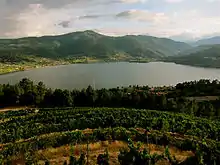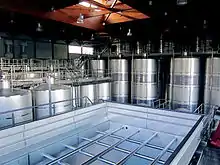Galician wine
Galician wine is Spanish wine made in the autonomous community of Galicia in the northwest corner of Spain. It includes wine made in the provinces of A Coruña, Ourense, Pontevedra and Lugo. Within Galicia are five Denominacións de Orixe (DO): Monterrei, Rías Baixas, Ribeira Sacra, Ribeiro and Valdeorras. In recent years, the region has seen a resurgence in its wine industry led by the international acclaim being received by the Rías Baixas region for its Albariño wines.[1]

Climate and geography

Located along the Atlantic coast, Galicia has a very wet climate with average rainfall of more than 50 inches (1,300 mm) a year. The more than 2000 hours of sunshine that the region receives helps contribute to the high humidity of the area. The Serra dos Ancares mountain range forms the border with Castile and León to the east, and the Miño river forms part of the region's border with Portugal to the south. The region's close proximity to Portugal and virtual isolation from the rest of Spain has had a marked influence on the style of wines from Galicia with many of them being closer in style to Portuguese wines than to other Spanish wines.[1]
The vineyard soils in the region range from granite in the Rías Baixas area and most of Galicia to slate in the Valdeorras region.[1][2]
History
In the 14th century, Galicia was exporting plant cuttings to other European vineyards. In the 19th century, the entire region suffered from a depressed economy and many vineyards shut down due to depopulation as workers moved away to find work. Galician harvest workers were a large part of the labor that developed the terrace vineyards in the Douro Port wine region. When Spain joined the European Union in 1986, funding assistance began reaching Galicia to help stimulate a resurgence in the wine industry.[1]
Viticulture and wines
.jpg.webp)
The region of Galicia has shown itself to be quite successful in harvesting grapes and regularly produces some of the highest yields in Europe, averaging 5.7 tons per acre (100 hl/ha). The majority of the area's vineyards are found to the south of the region in the provinces of Ourense and Pontevedra, though there are some significant plantings in Lugo to the east. The regions closer to the Miño river often produce blended wines of Albariño, Loureira and Caiño blanca. More inland the white wines are often blends of Torrontés and Treixadura. There are also white wines dominated by the Godello grape. The light red wines of the region are primarily made from the Mencía grape.[1]
Around 137 hectares (340 acres) of the Southwest France wine grape Camaraou noir (known in Galicia as Espadeiro) is grown here and often blended with Mencía and Caiño tinto.[3]
Wine regions
Monterrei
The Monterrei DO is found at the southern end of Galicia on the border with Portugal. The region was first granted provisional DO status in the early 1980s but lost the designation as Spanish authorities determined that the producers of Monterrei were not committed to upgrading their estates and improving wine quality. Spurred on by this event, the producers in Monterrei began modernizing their vineyards and wineries with the region regaining full DO status in 1994.[2]
The main wine grapes of Monterrei are Alicante, Doña blanca, Godello, Gran negro, Mencía, Mouratón and Palomino.[2] The wine industry here is currently dominated by bulk wine production.[1]
Rías Baixas
The Rias Baixas is the most well known region of Galicia and produces some of Spain's most sought after dry white wines based on the Albariño grape. While wines have been produced in this region for some time, exports of the wine to other areas of Europe didn't begin till 16th century and was kept at a steady pace till the phylloxera epidemic devastated the region's vineyards. At the turn of the 20th century many of the region's vineyards were replanted with low quality hybrid vines and some plantings of the Sherry grape Palomino that didn't produce as well in the cooler climate of Rías Baixas. In the 1970s growers began to replant native varieties like Albariño. Throughout the region 12 grape varieties are permitted, including the red wine grapes of Mencía and Espadeiro, but Albariño accounts for 90% of the region's production.[1]
The vineyard soils of the area are granite based and ideally situated for the damp maritime climate of the area. Despite the reputation for high yields in other parts of Galicia, Rías Baixas keeps the yield of its Albariño plantings low in order to produce concentrated fruity and fragrant wine. The wines are often a minimum alcohol content of 12% and are rarely produced in a style other than dry.[1]
Other grapes grown in Rías Baixas include Brancellao, Caiño tinto, Caiño blanca, Loureira, Loureira Tinta, Sousón, Torrontés and Treixadura.[2]
Rías Baixas (DO) is the Galician DO that exports most bottles of wine.
Ribeira Sacra
The Ribeira Sacra was granted DO status in 1996 and for most of the late 20th century and early 2000s the majority of the wine produced here was made from the Mencía grape with limited white wine production coming from the Godello and Albariño grape.[1] However, by the late 2000s, Palomino was the most widely planted grape in the region though Mencía still has a significant presence producing what wine expert Tom Stevenson calls "promising reds". Stevenson also notes that on the steep, terraced vineyards of Ribeira Sacra that Albariño has the potential to produce the most exciting wine.[2]
Other wine grapes grown in the Ribeira Sacra DO include Brancellao, Caiño tinto, Caiño blanca, Doña blanca, Espadeiro, Ferrón, Garnacha, Loureira, Loureira Tinta, Merenzao, Negrada, Sousón and Torrontés.[2]
Ribeiro

The Ribeiro DO (which means "river banks" in Galician) is located along the Miño river and its tributaries. It received its DO status in 1957. In the 16th and 17th century, Ribeiro wine was often exported to England and Italy but suffered the same damages as Rías Baixas did during the phylloxera epidemic. However, growers were quicker to turn away from the low quality hybrid plantings and back to the native Torrontés, Treixadura and Lado varieties. These grapes produce crisp, aromatic white wines. The area's red wine production is centered on the Garnacha Tintorera which produces dark colored but light bodied wines.[1]
Due to the similar climates and Atlantic influence, many of the wines of Ribeiro often share a style with the Portuguese wines from the nearby Vinho Verde region though wine expert Tom Stevenson notes that Ribeiro wines are often fruitier and more aromatic.[2]
Other grapes grown in the Ribeiro region include Albariño, Brancellao, Caiño tinto, Caiño blanca, Ferrón, Garnacha, Godello, Jerez, Loureira, Mencía, Sousón Tempranillo, Torronté, Treixadura and Viura.[2]
Valdeorras
The Valdeorras DO is the easternmost wine region of Galicia that is dominated by the red Garnacha Tintorera and the white Palomino grape. Many of the vineyards are planted in terraces on the steep slate hillsides that flank the Sil river.[2] Prior to the phylloxera epidemic of the 19th century, the indigenous Godello vine was heavily planted and is only just recently starting to make a comeback in the region. The Mencía grape is also starting to gain ground due to the fruity and easy drinking red wines that it produces.[1]
Other grapes grown in the Valdeorras region include Doña blanca, Godello, Gran negro, Lado, María Ardoña, Mencía, Merenzao and Palomino.[2]
References
- J. Robinson (ed) "The Oxford Companion to Wine" Third Edition pg 295-296, 451, 575, 723 Oxford University Press 2006 ISBN 0-19-860990-6
- T. Stevenson The Sotheby's Wine Encyclopedia Fifth Edition pgs 366-369 Dorling Kindersley (2011) ISBN 9780756686840
- J. Robinson, J. Harding and J. Vouillamoz Wine Grapes - A complete guide to 1,368 vine varieties, including their origins and flavours pgs 179-180, Allen Lane 2012 ISBN 978-1-846-14446-2

